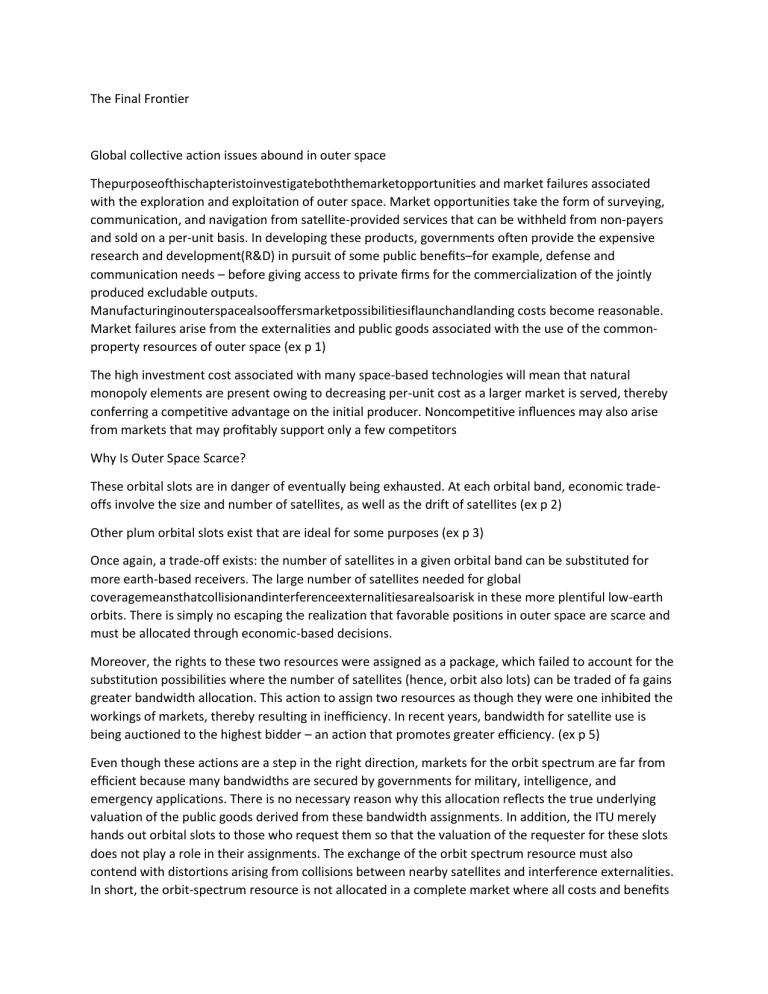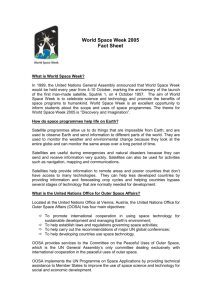notes
advertisement

The Final Frontier Global collective action issues abound in outer space Thepurposeofthischapteristoinvestigateboththemarketopportunities and market failures associated with the exploration and exploitation of outer space. Market opportunities take the form of surveying, communication, and navigation from satellite-provided services that can be withheld from non-payers and sold on a per-unit basis. In developing these products, governments often provide the expensive research and development(R&D) in pursuit of some public benefits–for example, defense and communication needs – before giving access to private firms for the commercialization of the jointly produced excludable outputs. Manufacturinginouterspacealsooffersmarketpossibilitiesiflaunchandlanding costs become reasonable. Market failures arise from the externalities and public goods associated with the use of the commonproperty resources of outer space (ex p 1) The high investment cost associated with many space-based technologies will mean that natural monopoly elements are present owing to decreasing per-unit cost as a larger market is served, thereby conferring a competitive advantage on the initial producer. Noncompetitive influences may also arise from markets that may profitably support only a few competitors Why Is Outer Space Scarce? These orbital slots are in danger of eventually being exhausted. At each orbital band, economic tradeoffs involve the size and number of satellites, as well as the drift of satellites (ex p 2) Other plum orbital slots exist that are ideal for some purposes (ex p 3) Once again, a trade-off exists: the number of satellites in a given orbital band can be substituted for more earth-based receivers. The large number of satellites needed for global coveragemeansthatcollisionandinterferenceexternalitiesarealsoarisk in these more plentiful low-earth orbits. There is simply no escaping the realization that favorable positions in outer space are scarce and must be allocated through economic-based decisions. Moreover, the rights to these two resources were assigned as a package, which failed to account for the substitution possibilities where the number of satellites (hence, orbit also lots) can be traded of fa gains greater bandwidth allocation. This action to assign two resources as though they were one inhibited the workings of markets, thereby resulting in inefficiency. In recent years, bandwidth for satellite use is being auctioned to the highest bidder – an action that promotes greater efficiency. (ex p 5) Even though these actions are a step in the right direction, markets for the orbit spectrum are far from efficient because many bandwidths are secured by governments for military, intelligence, and emergency applications. There is no necessary reason why this allocation reflects the true underlying valuation of the public goods derived from these bandwidth assignments. In addition, the ITU merely hands out orbital slots to those who request them so that the valuation of the requester for these slots does not play a role in their assignments. The exchange of the orbit spectrum resource must also contend with distortions arising from collisions between nearby satellites and interference externalities. In short, the orbit-spectrum resource is not allocated in a complete market where all costs and benefits are reflected in the price. If those who obtain the orbit slot from the ITU are later able to sell it to the highest bidder, then market efficiency is enhanced because the resource will be directed to its highestvalued application by the trading process. This outcome requires the ITU to vest the user with long-term ownership rights, including the right to trade. Economic efficiency is improved still further if the ITU auctions property rights to orbital slots. Outer Space, Collective Action, and Market Failure The exploitation of outer space is associated with a host of market failures. Because outer space has a large discovery component, an intergenerational public good of knowledge creation is involved. As with many discovery pursuits, abets-shot public good is germane in which the greatest effort is often the most likely to end in success (p 6) The ISS serves to represent both global collective action and inaction. In action arises because government officials are anticipated to underinvest in R&D projects that yield long-term benefits only after years of efforts (Cohen and Noll, 1986). Legislators and other elected officials will demonstrate impatience by foreshortening the R&D period to achieve results quickly that can be translated into constituent support during the next election. This impatience is aptly illustrated by NASA’s now-defunct philosophy to do things faster and cheaper. (p 6) Military uses of outer space have also produced some significant public goods. First, the pursuit of a strategic nuclear deterrent during the Cold War created breakthroughs in launch vehicles that later allowed satellites to be put into orbit for communication and other peaceful purposes that benefit everyone. The current generation of expendable launch vehicles (ELVs) are direct descendants of intercontinental ballistic missiles (ICBMs) and, in some recent launches, are modified ICBMs discarded owing to disarmament treaties. Second, the military developed the Internet, which has transformed communication in wondrous ways. Third, the US military developed the Global Positioning System (GPS) for targeting and other logistical purposes. GPS allows for the guidance of smart bombs and precisionguided munitions to their targets, thereby limiting collateral civilian casualties during conflict. Given the control that the military exercise dover these technologies, including choosing the timing of their release, the associated public benefits have been limited. There is a significant contrast between the approach that the EU is taking with respect to the commercialization of Galileo versus that of the United States with respect to GPS (p 7-8) , in contrast, the system has limited capacity so that military use rivals’ commercial applications in the strength of the signals, then critics are correct in pointing to Galileo as a more efficient arrangement since fees will internalize such nonzero crowding externalities. Moreover, the US Department of Defense (DOD) would be better able to calculate the true valuation of commercial (jointly produced) private benefits when upgrading the system if it were to share in the revenues. Currently, GPS needs to be upgraded to inhibit hostile jamming and meet current standards for air-traffic control and other applications (Braunschvig, Garwin, andMarwell,2003). As hare of the revenues from such applications would greatly assist DOD in designing the capacity and capabilities of the next generation of GPS. Commercial users will decide between the two systems based on their marginal willingness to pay: those users with a high valuation for signal accuracy will choose Galileo over GPS. A future potential intergenerational public good could come from the use of outer space to sequester plutonium and other highly radioactive element. (p 8) In the case of a launch accident, the risk of a radiation release could be made negligible if the pay load in casement can withstand the consequences of a failure. Thus, payload encasement reliability can be traded off against launcher reliability Market failures in outer space may arise from externalities. Signals transmitted by satellites may not only interfere with other satellites but also with space probes (for example, Voyager), whose signals when be a midback to earth may be blocked by satellites in the air transmission’s pathway. When receiving or transmitting signals, satellites may interfere with one another not only in the same altitude band but also in different altitude bands. Because satellite interference often implies some kind of reciprocal externality, there is an incentive among satellite operators to reach an accommodation. For satellite collisions, there is the added impetus for a negotiated outcome since potential accidents only involve one or two won ear by satellites unlike signal interference, which may affect many satellites at different orbital bands Clearly, the owner of such space debris is easy to identify so that the difficult collective action problem is devising an enforcement mechanism. There are, of course, perverse incentives for those nations with large objects in orbit to assume liability once an accident occurs Launch Vehicle The current race in outer space is for the development of the next generation of RLVs to replace the aging Space Shuttle, the only currently operational RLV. In Table 11.2, some of the current contenders in this competition are listed with their developer and key features The development of the next set of operational RLVs (Reusable launch system) is a better-shot public good, where alternative designs can provide greater service reliability when a crash grounds one type of RLV as the cause is being investigated. Thus, even a second-best technology has something to offer in terms of enhanced reliability and increased diversity. Cost per launch would have been smaller if a greater number of launches could have spread the large fixed development cost over more flights. Moreover, UAVs can fulfill many chores where proximity is advantageous including security against terrorism, surveying the planet, monitoring the troops here, and providing broadband communications. Although UAVs can supply some satellite services, they cannot replace satellites – their low altitude gives them very limited coverage compared with satellites, especially those in geostationary space. If used for defense purposes, UAVs are relatively easy targets compared with low-earth satellites, which are higher and not stationary. Conflict and Outer Space The development of a national missile defense is the ultimate best-shot public good where the greatest and most sustained effort that the greatest likelihood of success, given the technological complexities. Once the system is deployed, the United States has no choice but to protect virtually everyone: once a missile is fired, there is almost not to determine if US territory or its interests abroad are the intended target. Globalization has dispersed US people, property, and interest sufficiently that any missile from a rogue state or terrorist group would have to be taken as a threat and destroyed. If the missile releases decoy early in its flight as is true of Russian and American ICBMs, then this makes it even more imperative to destroy the missile during the initial three to four-minute boost stage. Thus, US allies and other nations can merely free ride on the US system if developed; nations would have no incentive to buy into the systems. Markets and Clubs Outer space gives one the impression of nonexcludable and nonrival goods. Surely, the light show displayed by an exploding star has both of these classic properties of a public good, as does a solar flare that disrupts satellite and terrestrial communications. Infect, outer space presents many market and club opportunities that can achieve near-efficient outcomes. Markets are particularly suited to space manufacturing as in the case of pharmaceuticals whose crystalline structure is enhanced in zero gravity conditions. For space manufacturing to be profitable, there must be a high value to weight because launch and reentry costs are so high. Space manufacturing will become more feasible once launch costs are reduced. As in an ideal club, the shared good’s capacity and provision level is tailored to the level of utilization or the size of the market (p 15-16) The INTELSAT communication system represents a club good since network access is restricted by coding or scrambling signals. Additionally, the network can be simultaneously used by its 400 members, which include countries, Internet service providers, telecommunication companies, broadcasters, corporate networks,9 and international organizations. Members ‘use can be monitored, and tolls charged accordingly. As utilization of the system increases, the benefits per signal transmitted diminish owing to congestion as an increased volume of signals share the same frequency band. A club arrangement canal locate utilization rates efficiently based on congestion-based toll charges (see Chaps. 2 and 3). Every user pays the same toll per unit of utilization as reflected by, say, a second of transmission or reception using the network. The toll values the congestion imposed on the membership from this unit of use. Users’ total toll payments are then based on their number of units of transmission or reception times the toll. Those members who transmit and receive more signals pay more in total tolls as their utilization rate reveals their true preferences for the network. The current structure of INTELSAT conforms closely to that of an economic club where members pay fees according to their utilization on a per unit basis, and voting at meetings of the Board of Governors is weighted based on the members’ utilization rates and investment share A utilization-weighted voting scheme is consistent with efficiency because heavier users (for example, a telecommunication company) will be serving more individuals whose interests must be reflected, and consequently these heavier users will support a greater share of the costs resulting from policy changes. To revenues support the system and underwrite investment in upgrades and increased capacity This club structure does not necessitate nations sacrificing their political autonomy to the wishes of the majority; members determine their own levels of utilization and can choose to leave the system if they wish. Space Exploration As with most discoveries, outer space exploration has a strong public good component. The United States receives private benefits through prestige and the ability to assign observation times to others as they choose Given that the payoffs from these probes are in the future and benefit everyone, a suboptimal amount of this exploratory effort is anticipated The underlying aggregation technology for space exploration is best shotwhereeffortsmaybebestpooledforactivitiesinwhichknownthresholds must be surpassed. In other instances, the discovery process may be lesseasilycharteredsothatmultiplediverseeffortsareneededtostumble on the discovery When sending unmanned probes to Mars, much less investment is required; therefore, multiple efforts with diverse designs are more likely to yield a wider range of discoveries than pooling efforts with a single complex probe Multiple approaches also minimize the risk of failure – for example, the failure of ESA’s Beagle 2 to communicate after landing on Mars in December 2003. The ISS is noteworthy as a supreme instance of global collective action that involves many different kinds of contributions from numerous countries. The United States plays a crucial leadership role in terms of technological knowledge, financial resources, and launch and reentry capabilities. This collective action was also fostered by the relatively small number of key countries needed at the outset for the endeavor – just the United States and Soviet Union – which limited transaction costs. Later other important participants – most notably, the ESA – joined the project. All participants receive some nation-specific benefits that serve to motivate participation; for example, the ISS allowed the Russians to maintain a space laboratory during the difficult economic times following the collapse of the Soviet Union. Global collective action for the ISS was a promoted because the earlier space laboratory took away a lot of the uncertainty about the feasibility and the potential gains from a human presence in space. All participants would gain; there would be no losers from participation. The international presence reduced the likely hood that the colony would be diverted to military purposes. Once the major expenditures were covered by the United States, future participants could easily achieve a net positive benefit since cost would be small. Thus, the ISS possesses many of the factors that bolster collective action at the global level. As the major stake holder in the ISS, the United States could influence which countries participated and their level of involvement, which is a crucial US-specific benefit. Bush’s plan tore focus NASA’s exploration program, announced in January 2004, jeopardizes the long-run future of the ISS. Space Wanderers and Collisions As termites hitting the earth is bad thus Acting against such a pending collision is the quintessential bestshot public good with intergenerational benefits. If given sufficient warning – a hundred years or more, humankind could conceivably avert the pending disaster by arming a vessel with explosives and sending it on a distant rendezvous in space with the intruder Both the process of discovering the menace and the development of the averting technology require a pooling of effort. The United States is expending much of the discovery activity, and some observations are being made by astronomers from other countries in their normal viewing of the heavens. The more problematic action is to be technologically ready to divert the asteroid or comet if the threat ever materializes. Thus far, there is no formal cooperative arrangement among countries with launch capabilities to develop the technology. Perhaps, the hope is that the technology being developed to probe the solar system can be readily converted to carry out the diversion mission. Clearly, the relatively low probability of the event works against a concerted effort to be prepared Concluding Remarks Outer space offers the next market frontier for a globalizing world as well as a new set of market failures to address. Given the ever-widening technological gap between the United States and other countries, the world has little choice but to rely on the United States to provide the bestshotpublicgoodsassociatedwithspaceexplorationandprotectionofthe planet. In both cases, under provision is anticipated as benefits to other countries’ residents and future generations are undercounted or left out of the US decision calculus. A basic message of this chapter is that market opportunities do exist in outer space and will grow greatly as launch costs are reduced through technological breakthroughs and competition. Another message is that clubs represent a low-cost and essential institutional form for promoting allocative efficiency for satellite networks and applications. A third message is that the widening gap between the rich and poor countries will become larger through the exploitation of outer space. Many of the technologies utilized by outer space clubs and markets have been developed by governments and later given to commercial ventures. As a consequence, their initial pricing structure does not reflect long-run marginal cost including development expenditure. Whether a conscious choice or not, INTELSAT has gravitated to an institutional form that appears appropriate and efficient. This same club structure is appropriate for Galileo’s radio navigation system, which should foster locative efficiency by providing a higher quality product than GPS for those prepared to pay the price.



